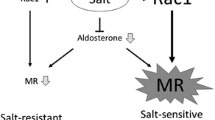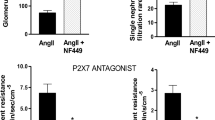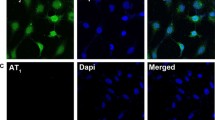Abstract
Angiotensin II plays a central role in the pathogenesis of hypertension and of related cardiovascular disorders by binding to and activating angiotensin II receptors (AT1 receptors). Sensitization to the vasopressor response of angiotensin II is a key feature in many cardiovascular disorders. However, underlying mechanisms responsible for angiotensin II hypersensitivity are barely understood. Because angiotensin II responsiveness of AT1 receptors can be specifically modified by AT1/B2 receptor dimerization, we determined the AT1 receptor dimerization status in an experimental model of hypertension. AT1/B2 receptor heterodimers were abundant on renal mesangial cells isolated from spontaneously hypertensive rats compared with that on cells from normotensive controls. Heterodimerization of AT1 with B2 receptors was correlated with high levels of B2 receptor protein on kidneys and on mesangial cells of hypertensive rats, as determined in immunoblot with receptor-specific antibodies. Specific inhibition of AT1/B2 receptor heterodimers revealed that these receptor heterodimers mediated an enhanced angiotensin II-stimulated Gαq/11 activation and an increased endothelin-1 secretion of mesangial cells from hypertensive rats. Thus, AT1/B2 receptor heterodimerization contributes to angiotensin II hyperresponsiveness of mesangial cells in experimental hypertension.
Similar content being viewed by others
References
AbdAlla S., Lother H., and Quitterer U. (2000) AT1 receptor heterodimers show enhanced G-protein activation and altered receptor sequestration. Nature 407, 94–98.
AbdAlla S., Lother H., Abdel-Tawab A., and Quitterer U. (2001a) The angiotensin II AT2 receptor is an AT1 receptor antagonist. J. Biol. Chem. 276, 39721–39726.
AbdAlla S., Lother H., Massiery A., and Quitterer U. (2001b) Increased AT1 receptor heterodimers in preeclampsia mediate enhanced angiotensin II responsiveness. Nat. Med. 7, 1003–1009.
Agnati L. F., Ferre S., Lluis C., Franco R., and Fuxe K. (2003) Molecular mechanisms and therapeutical implications of intramembrane receptor/receptor interactions among heptahelical receptors with examples from the striatopallidal GABA neurons. Pharmacol. Rev. 55, 509–550.
Alfie M. E., Yang X.-P., Hess F., and Carretero O. A. (1996) Salt-sensitive hypertension in bradykinin B2 receptor knockout mice. Biochem. Biophys. Res. Commun. 224, 625–630.
Allen T. J., Cao Z., Youssef S., Hulthen U. L., and Cooper M. E. (1997) Role of angiotensin II and bradykinin in experimental diabetic nephropathy. Functional and structural studies. Diabetes 46, 1612–1618.
Beenen O. H., Mathy M. J., Pfaffendorf M., and van Zwieten P.A. (1996) Vascular responsiveness in isolated perfused kidneys of diabetic hypertensive rats. J. Hypertens. 14, 1125–1130.
Collis M. G. and Vanhoutte P. M. (1978) Increased renal vascular reactivity to angiotensin II but not to nerve stimulation or exogenous norepinephrine in renal hypertensive rats. Circ. Res. 43, 544–552.
Correa F. M. A., Viswanathan M., Ciuffo G. M., Tsutsumi K., and Saavedra J. M. (1995) Kidney angiotensin II receptors and converting enzyme in neonatal and adult Wistar-Kyoto and spontanously hypertensive rats. Peptides 16, 19–24.
Fotiadis D., Liang Y., Filipek S., Saperstein D. A., Engel A., and Palczewski K. (2004) The G protein-coupled receptor rhodopsin in the native membrane. FEBS Lett. 564, 281–288.
Ikeda M., Kohno M., and Takeda T. (1995) Endothelin production in cultured mesangial cells of spontaneously hypertensive rats. Hypertension 25, 1196–1201.
Jacobi J., Schlaich M. P., Delles C., Schobel H. P., and Schmieder R. E. (1999) Angiotensin II stimulates left ventricular hypertrophy in hypertensive patients independently of blood pressure. Am. J. Hypertens. 12, 418–422.
Kost C. K., Li P., Williams D. S., and Jackson E. K. (1998) Renal vascular responses to angiotensin II in conscious spontaneously hypertensive and normotensive rats. J. Cardiovasc. Pharmacol. 31, 854–861.
Lassila M., Finckenberg P., Pere A. K., Krogerus L., Ahonen J., Vapaatalo H., and Nurminen M. L. (2000) Comparison of enalapril and valsartan in cyclosporine A-induced hypertension and nephrotoxicity in spontaneously hypertensive rats on high-sodium diet. Br. J. Pharmacol. 130, 1339–1347.
Ljungman S., Aurell M., Hartford M., Wikstrand J., and Berglund G. (1983) Effects of subpressor doses of angiotensin II on renal hemodynamics in relation to blood pressure. Hypertension 5, 368–374.
Plante G. E., Bissonnette M., Sirois M. G., Regoli D., and Sirois P. (1992) Renal permeability alteration precedes hypertension and involves bradykinin in the spontaneously hypertensive rat. J. Clin. Invest. 89, 2030–2032.
Quitterer U., Lother H., and AbdAlla S. (2004) AT1 receptor heterodimers and angiotensin II responsiveness in preeclampsia. Semin. Nephrol. 24, 115–119.
Song Q., Wang D. Z., Harley R. A., Chao L., and Chao J. (1996) Cellular localization of low-molecular-weight kininogen and bradykinin B2 receptor mRNAs in human kidney. Am. J. Physiol. 270, F919-F926.
Sorokin A. and Kohan D. E. (2003) Physiology and pathology of endothelin-1 in renal mesangium. Am. J. Physiol. Renal Physiol. 285, F579-F589.
Terrillon S. and Bouvier M. (2004) Roles of G-protein-coupled receptor dimerization. EMBO Rep. 5, 30–34.
Webb R. C., Johnson J. C., Vander A. J., and Henry J. P. (1983) Increased vascular sensitivity to angiotensin II in psychosocial hypertensive mice. Hypertension 5, 1165–1169.
Widgren B. R., Herlitz H., Aurell M., Berglund G., Wikstrand J., and Andersson O. K. (1992) Increased systemic and renal vascular sensitivity to angiotensin II in normotensive men with positive family histories of hypertension. Am. J. Hypertens. 5, 167–174.
Zoja C., Donadelli R., Corna D., Testa D., Facchinetti D., Maffi R. et al. (1997) The renoprotective properties of angiotensin-converting enzyme inhibitors in a chronic model of membraneous nephropathy are solely due to the inhibition of angiotensin II: evidence based on comparative studies with a receptor antagonist. Am. J. Kidney Dis. 29, 254–264.
Author information
Authors and Affiliations
Corresponding author
Rights and permissions
About this article
Cite this article
AbdAlla, S., Abdel-Baset, A., Lother, H. et al. Mesangial AT1/B2 receptor heterodimers contribute to angiotensin II hyperresponsiveness in experimental hypertension. J Mol Neurosci 26, 185–192 (2005). https://doi.org/10.1385/JMN:26:2-3:185
Issue Date:
DOI: https://doi.org/10.1385/JMN:26:2-3:185




